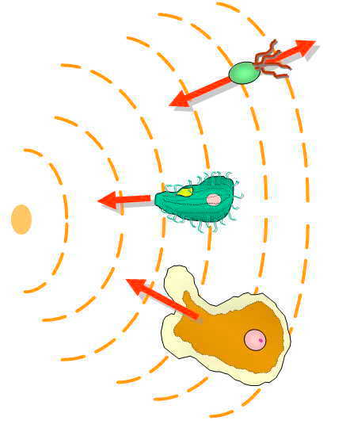User:Tyleryan/sandbox
Original- "Chemotaxis"
Eukaryotic chemotaxis[edit]

The mechanism that eukaryotic cells employ is quite different from that in bacteria; however, sensing of chemical gradients is still a crucial step in the process.[1][better source needed] Due to their size, prokaryotes cannot detect effective concentration gradients; therefore, these cells scan and evaluate their environment by a constant swimming (consecutive steps of straight swims and tumbles). In contrast, the size of eukaryotic cells allows for the possibility of detecting gradients, which results in a dynamic and polarized distribution of receptors; induction of these receptors by chemoattractants or chemorepellents results in migration towards or away from the chemotactic substance.[citation needed]
References[edit]
- ^ Köhidai, Laszio (2016), "Chemotaxis as an Expression of Communication of Tetrahymena", in Witzany, G; Nowacki, M (eds.), Biocommunication of Ciliates, pp. 65–82, doi:10.1007/978-3-319-32211-7_5, ISBN 978-3-319-32211-7
Edit- "Chemotaxis"
Eukaryotic chemotaxis[edit]

The mechanism of chemotaxis that eukaryotic cells employ is quite different from that in bacteria; however, sensing of chemical gradients is still a crucial step in the process.[1][better source needed] Due to their small size, prokaryotes cannot directly detect a concentration gradient. Instead, prokaryotes sense their environments temporally, constantly swimming and redirecting themselves each time they sense a change in the gradient.[2][3]
Eukaryotic cells are much larger than prokaryotes and have receptors embedded uniformly throughout the cell membrane. [2] Eukaryotic chemotaxis involves detecting a concentration gradient spatially by comparing the asymmetric activation of these receptors at the different ends of the cell.[2] Activation of these receptors results in migration towards chemoattractants, or away from chemorepellants. [2]
It has also been shown that both prokaryotic and eukaryotic cells are capable of chemotactic memory.[3][4] In prokaryotes, this mechanism involves the methylation of receptors called methyl-accepting chemotaxis proteins (MCPs).[3] This results in their desensitization and allows prokaryotes to "remember" and adapt to a chemical gradient.[3] In contrast, chemotactic memory in eukaryotes can be explained by the Local Excitation Global Inhibition (LEGI) model.[4] LEGI involves the balance between a fast excitation and delayed inhibition which controls downstream signaling such as Ras activation and PIP3 production.[4]
References[edit]
- ^ Köhidai, Laszio (2016), "Chemotaxis as an Expression of Communication of Tetrahymena", in Witzany, G; Nowacki, M (eds.), Biocommunication of Ciliates, pp. 65–82, doi:10.1007/978-3-319-32211-7_5, ISBN 978-3-319-32211-7
- ^ a b c d Levine, Herbert; Rappel, Wouter-Jan (2013). "The physics of eukaryotic chemotaxis". Physics Today. 66 (2): 24. doi:10.1063/PT.3.1884. Retrieved 7 October 2017.
- ^ a b c d Vladimirov, Nikita; Sourjik, Victor (Nov 2009). "Chemotaxis: how bacteria use memory" (PDF). Biological Chemistry. 390 (11): 1097-1104. doi:10.1515/BC.2009.130. Retrieved 20 November 2017.
- ^ a b c Skoge, Monica; Yue, Haicen; Erickstad, Michael; Bae, Albert; Levine, Herbert; Groisman, Alex; Loomis, William F.; Rappel, Wouter-Jan (2014). "Cellular memory in eukaryotic chemotaxis" (PDF). Proceedings of the National Academy of Sciences. 111 (40): 14448–14453. doi:10.1073/pnas.1412197111. Retrieved 23 September 2017.
{{cite journal}}: Cite has empty unknown parameter:|1=(help)
